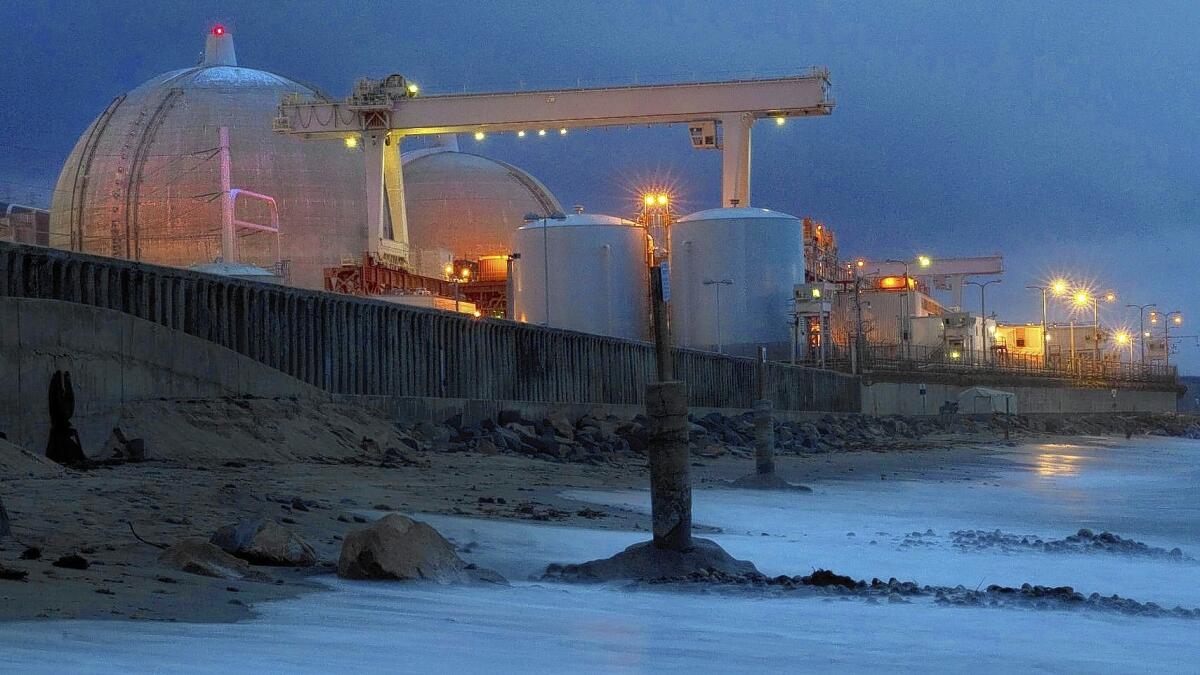Battles over San Onofre nuclear plant costs gaining steam

- Share via
SACRAMENTO — Heated battles over who pays for last year’s permanent closure of the San Onofre nuclear power plant — and how much — are just getting started. Even some consumer groups are already at odds with each other.
Experts peg the immediate cost at $4.7 billion to pay for utility investments, replacement power and ongoing maintenance relating to the early shutdown of two reactors at the San Onofre Nuclear Generating Station.
A proposed settlement would initially apportion the costs so that $3.3 billion would be covered by ratepayers and $1.4 billion by utility shareholders.
In coming years, an additional $4 billion-plus will be needed to remove radioactive materials and demolish the plant safely.
Ultimately, it will be up to the California Public Utilities Commission and possibly the courts to decide who pays which final bills.
In the meantime, battles are underway among utilities, ratepayers, equipment makers, consumer groups and insurance companies. And the current deep disagreements could be just the beginning of protracted legal combat.
“The prognosis for a rapid resolution of the San Onofre decommissioning is not good,” said Daniel Hirsch, a lecturer on nuclear policy at UC Santa Cruz. “It’s an extraordinarily long and remarkably difficult undertaking to have ahead.” Hirsch is also a longtime anti-nuclear-power activist.
The two utilities that own the plant — Southern California Edison Co. and its junior partner, San Diego Gas & Electric Co. — are in early stages of legal proceedings with Japan’s Mitsubishi Heavy Industries, the maker of the defective $680-million steam generators. One of the sets of generators developed a leak that released a small amount of radioactivity.
That equipment failure in January 2012 led to Edison’s decision to shutter the plant 18 months later.
In recent months, the utilities and two consumer advocate organizations held a series of confidential negotiations that led to the proposed settlement on how to apportion the $4.7-billion immediate cost.
The ratepayer organizations, the Utility Reform Network, known as TURN, and the PUC’s independent Office of Ratepayer Advocate — managed to pare $1.4 billion off Edison’s initial demand that its shareholders recover the full $4.7 billion.
That was “a huge win for consumers,” said Matthew Freedman, chief negotiator for TURN. The high point, he said, was Edison’s forgoing of all the money it would have collected from customers for the faulty steam generators, once the plant stopped producing electricity.
The agreement, Freedman said, was “the best we could get given the law we have” and the political reality of doing business at the five-member PUC.
But other consumer representatives in southern Orange and San Diego counties protested to the PUC. They said the agreement unfairly favored Edison and SDG&E at the expense of utility customers, who have been paying for San Onofre via monthly electric bills for three decades.
The dissidents petitioned the PUC to throw out the proposed settlement. They asked the commission, instead, to investigate alleged Edison negligence in installing unproven steam generators and alleged collusion between Edison and TURN on a sweetheart deal.
San Diego County lawyer Michael J. Aguirre and local activist groups say that Edison and SDG&E should pay for the bulk of San Onofre’s costs because Edison executives’ “unreasonable” actions contributed to the failure of the steam generators, he said.
“The burden falls on the shoulders of the investors,” Aguirre said, “not on the ratepayers.”
Freedman dismissed Aguirre’s claims as “ludicrous,” while Edison in a legal brief called them irrelevant.
Both sides will argue their cases before two PUC administrative law judges at a hearing Wednesday in San Francisco. The PUC has scheduled a community meeting on the proposed settlement for June 16 in Costa Mesa. The five-member commission is expected to make a decision in late summer or early fall.
Once the initial closing costs are resolved, the PUC, along with federal regulators, will begin the more arduous task of decommissioning the power plant complex, which is located on 438 acres of Navy-owned land near the Camp Pendleton Marine Base.
The expensive, painstaking and potentially dangerous process involves the removal and isolated storage of spent fuel rods and other radioactive materials. It is expected to take seven to 10 years to complete.
Most of the estimated $4.1-billion decommissioning cost already has been collected from ratepayers and is being held by the PUC.
Twitter: @MarcLifsher
More to Read
Inside the business of entertainment
The Wide Shot brings you news, analysis and insights on everything from streaming wars to production — and what it all means for the future.
You may occasionally receive promotional content from the Los Angeles Times.











